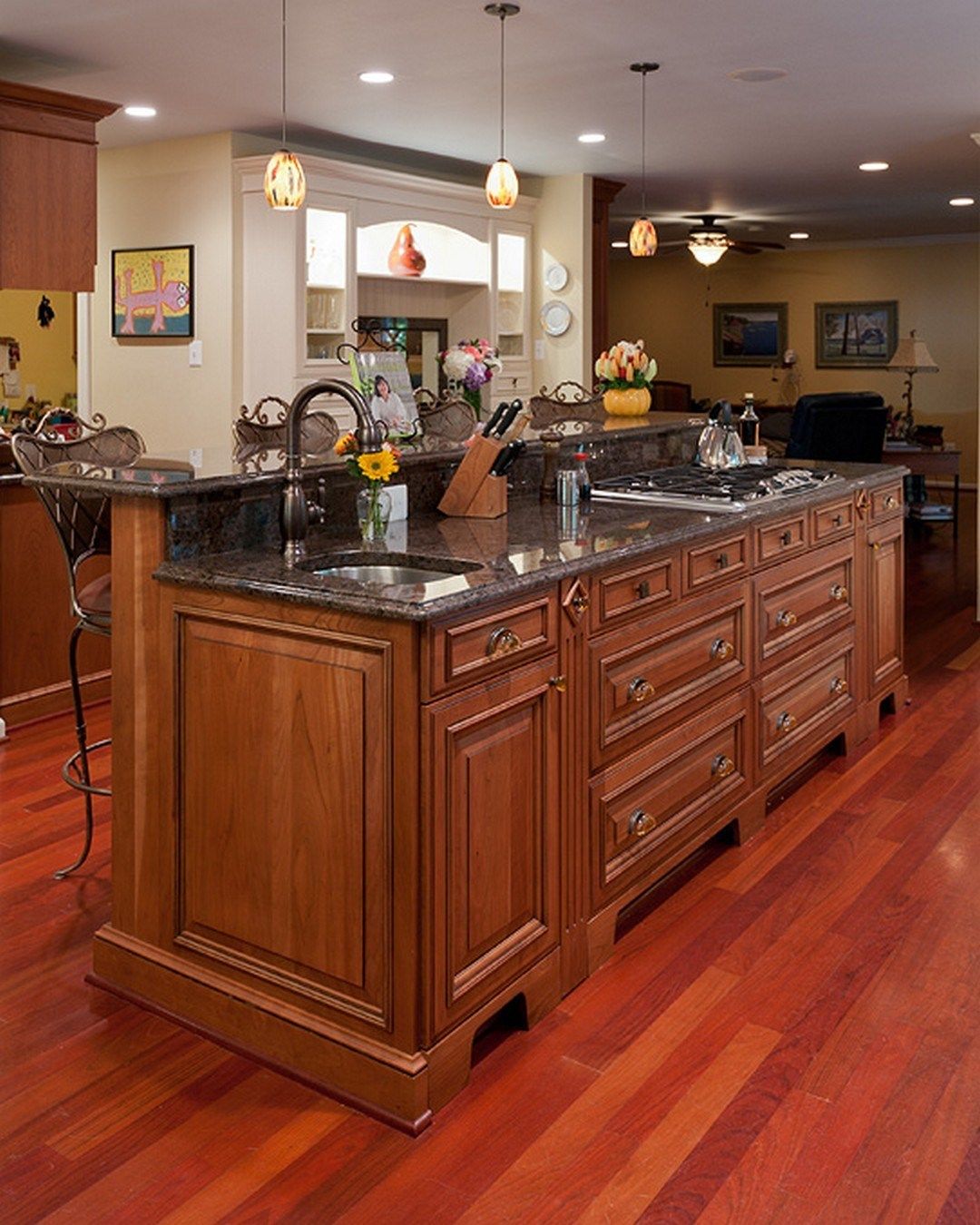Picture this: a kitchen island in the heart of your home, not just any island, but one with a stove, turning it into the focal point of your cooking adventures. This guide will help you embark on a journey of creating the kitchen of your dreams, exploring the endless possibilities of designing your kitchen island with a stove. From the practical benefits to the aesthetic appeal, we’ll cover it all, empowering you to transform your kitchen into a culinary masterpiece.
Igniting Your Kitchen’s Potential: Benefits & Design Considerations
Okay, let’s talk kitchen dreams! Imagine this: a gorgeous kitchen island, smack-dab in the middle of your culinary haven, complete with a built-in stove. It’s the epitome of modern kitchen design, blending practicality with pure aesthetic pleasure. Whether you’re a whiz in the kitchen or just love a stylish space, this guide is your go-to for incorporating a stove into your kitchen island.
Why a Kitchen Island Stove Rocks!
Let’s be real, having a stove in your island isn’t just about looks (though it definitely ups your kitchen’s wow factor). Here’s why it’s a game-changer:
- Cooking Just Got Easier: Picture this – no more running back and forth between your countertop and stove. With the stove as your island’s centerpiece, everything you need is within arm’s reach. Talk about efficient cooking!
- Party Central: Your kitchen island already draws people in, but with a stove, it becomes the heart of the action. Guests can hang out, chat, and maybe even snag a taste test while you cook. Instant social butterfly mode!
- Home Value on the Rise: Let’s be honest, a well-designed kitchen island with a stove is a major selling point. Think of it as an investment that screams “luxury” to potential buyers.
Designing Your Dream Island: Things to Consider
Before you get lost in Pinterest inspiration, let’s break down the practical stuff:
Space: The Final Frontier
- Island Size and Shape: You want an island that’s big enough to work on comfortably, with plenty of storage space, but not so big that it makes your kitchen feel cramped. Consider the overall flow and how much space you need to move around freely.
- The Magic Triangle: Ever heard of the kitchen work triangle? It’s the golden rule for kitchen layouts – an imaginary triangle connecting your sink, refrigerator, and stove. Keeping these three points in mind will make your kitchen super efficient. Make sure your island design doesn’t disrupt this flow.
- Traffic Flow: Speaking of flow, think about how people move through your kitchen. Leave enough space around the island so that everyone can move comfortably, especially when you’ve got a crowd over.
Ventilation is Key
- Range Hood Heroes: A powerful range hood is non-negotiable when you’ve got a stovetop on your island. It’ll whisk away those cooking smells and keep your kitchen air fresh.
- Ductwork Dreams: Hidden, but oh-so-important – make sure you’ve got proper ductwork installed for your range hood. This ensures efficient ventilation and prevents unwanted smoke or smells from taking over.
Safety First, Always!
- Heat-Resistant Surfaces: Hot pans and countertops don’t mix! Choose heat-resistant materials like granite, quartz, or concrete for your island countertop and the surrounding areas to prevent any mishaps.
- Kid-Friendly Design: Rounded edges on your island and strategically placed stove controls can go a long way in creating a safe environment, especially if you have little ones running around.
Picking the Perfect Stove
Now for the fun part – choosing the star of your island! Here’s what to consider:
Cooktop Types: The Great Debate
- Gas Stoves: The chef’s favorite! Gas stoves offer fantastic heat control, but they require proper ventilation (remember that range hood!).
- Electric Stoves: If easy cleaning is your priority, electric stoves are a solid choice. Just keep in mind that they might not offer the same precise heat control as gas.
- Induction Stoves: Energy efficiency and lightning-fast heating are the hallmarks of induction stoves. They’re sleek and modern, but you’ll need compatible cookware to use them.
Size and Features: Finding Your Match
- Burner Bonanza: How many burners do you really need? Think about your cooking style and how many dishes you typically make at once to find the right fit.
- Special Features: Want to take your cooking game to the next level? Look for stoves with built-in griddles, grills, or warming zones.
Style and Inspiration: Making it YOURS!
This is where your personal style shines through!
Cabinetry and Countertops: Setting the Tone
- Material World: From sleek and modern to warm and rustic, there’s a material out there to match your kitchen’s vibe. Consider wood, laminate, quartz, or granite for your cabinets and countertops.
- Colors and Finishes: Don’t be afraid to play with color and texture! Choose colors and finishes that reflect your personal style and create the atmosphere you’re going for.
Seating: Gather ‘Round
- Bar Stool Bliss: Comfortable and stylish bar stools are a must-have for your island. Make sure they’re the right height for your countertop and complement the overall look.
- Seating Capacity: Think about how many people you want to accommodate at your island. Do you love hosting big dinners or prefer a cozy space for family meals?
Lighting: Setting the Mood
- Task Lighting: Good lighting is crucial for any kitchen, especially when you’re cooking. Install under-cabinet lighting or a pendant light above the stovetop to illuminate your workspace.
- Ambient Lighting: Create a warm and inviting atmosphere with ambient lighting. Recessed lighting or track lighting can do wonders.
Installation and Costs: The Nitty Gritty
- Leave it to the Pros: When it comes to electrical, plumbing, and ventilation, it’s best to call in licensed professionals. They’ll ensure everything is installed safely and up to code.
- Breaking Down the Costs: The cost of your island will depend on various factors, including materials, appliance choices, and labor costs. Don’t forget to factor in installation fees!
- Budgeting Tips: Want to keep costs down? Consider using more affordable materials or opting for a slightly smaller island.
Maintenance and Care: Keeping it Sparkling
- Cleaning Made Easy: Regularly wipe down your countertops and stovetop with appropriate cleaning solutions.
- Preventative Maintenance: Give your ventilation system a little TLC every now and then. Regular cleaning and inspection will keep it running smoothly for years to come.
There you have it—your comprehensive guide to designing the kitchen island with a stove of your dreams! Remember, this is your chance to create a space that reflects your unique style and culinary needs. Embrace the process, have fun, and get ready to cook up a storm in your stunning new kitchen!
Is It Okay to Have a Stove in an Island? Deconstructing the Pros, Cons & Safety
So, you’re thinking about putting a stove in your kitchen island? It’s a popular trend for a reason! Island cooktops create a sleek, modern aesthetic and offer a new level of convenience to your cooking experience. However, some important considerations come with this increasingly popular design choice. Let’s weigh the pros and cons a bit more.
Benefits of an Island Stovetop
On the plus side, having your stovetop right there in the island can make cooking a breeze. You can easily reach everything from all sides, which is super helpful when you’re juggling multiple dishes.
An island stovetop can:
* Free up valuable counter space along the walls of your kitchen, giving you more room for appliances or just spreading out while you prep ingredients.
* Become the focal point of your kitchen, creating a more social and inclusive atmosphere, especially when entertaining.
Drawbacks to Consider
However, there are some important things to consider when it comes to safety, especially if you have little ones running around. Open flames and hot surfaces on an island might be easier for curious kids to reach, so you’ll need to think about childproofing measures.
Additional drawbacks to consider:
- Foot Traffic: An island stovetop can sometimes mean more foot traffic passing close by, which could lead to accidental bumps and spills.
- Ventilation: Since your stove will be out in the open, you’ll need a really good range hood to suck up all the cooking smells and smoke. Otherwise, your kitchen might end up smelling like last night’s dinner for hours! This will likely require additional ductwork.
- Limited Storage: You’ll lose some under-island cabinet space where your oven would typically go.
Design & Cost Implications
Before you commit to an island stove, you’ll also want to think about the layout and design of your kitchen. Is your island big enough to comfortably fit a stovetop and still have enough counter space for prepping? Will there be enough room for people to move around without feeling cramped?
And let’s not forget about the practical aspects, like electrical wiring and plumbing. Installing a stovetop on an island means running dedicated electrical lines and potentially water lines if you’re opting for a gas cooktop. These additions can sometimes add to the overall cost of the project, so it’s good to factor that in.
Ultimately, the decision of whether or not to have a stove in your island depends on your individual needs, lifestyle, and kitchen setup. There’s no right or wrong answer, but by carefully considering the benefits and potential drawbacks, you can make an informed choice that works best for you and your home.
Can You Buy an Island With a Stove? Finding Your Perfect Fit
You absolutely can buy an island with a built-in stove! It’s becoming a popular choice for homeowners who want to create a stylish and functional kitchen. You can find pre-made islands with stoves already installed, or you can work with a designer to create a custom island that perfectly fits your space and cooking needs.
Imagine this: you’re whipping up a delicious meal, pots bubbling away on your island cooktop while you chat with friends and family gathered around. That’s the beauty of having an island with a stove – it truly becomes the heart of your kitchen.
Why Choose an Island Stove?
Island stoves offer some great perks. They often provide extra counter space, which is always a plus in a kitchen. They can also become a dramatic focal point, especially if you choose a striking range hood to go with it. Plus, having your stovetop in the island can improve your kitchen’s flow, making it easier to move around while you cook.
Ventilation is Key
One thing to keep in mind, though: ventilation is super important with an island stove. Since it’s not against a wall, you’ll need a powerful range hood or downdraft system to whisk away smoke and cooking odors. These systems can sometimes be pricey, so factor that into your budget.
Safety First
Of course, safety is paramount, especially if you have young children. Make sure your island has heat-resistant surfaces around the stovetop, and consider installing safety features to prevent accidental burns. It’s always a good idea to supervise kids closely in the kitchen, especially when the stove is on.
Cost Considerations
Speaking of budget, the price of an island with a stove can vary widely. Pre-made units tend to be more affordable, while custom designs can get quite expensive. The type of stovetop you choose (gas, electric, induction) will also impact the overall cost.
Weighing the Pros and Cons
Still not sure if an island stove is right for you? Here’s a handy list of pros and cons to help you decide:
Pros:
- Centralized Cooking: It’s like having your own cooking command center!
- Enhanced Workflow: Moving between your prep space, sink, and stovetop becomes a breeze.
- Increased Counter Space: Who doesn’t love more room to work their culinary magic?
- Stunning Visual Impact: An island stove can really elevate your kitchen’s style.
- Design Versatility: You can customize your island to perfectly match your kitchen’s aesthetic.
Cons:
- Higher Installation Costs: You’ll likely need to hire an electrician and plumber, which can add up.
- Complex Electrical & Plumbing Requirements: Running gas lines or high-voltage wiring to an island can be tricky.
- Limited Cabinet Space Below for Storage: You’ll lose some storage space by having a stovetop in your island.
- Potential Safety Hazard for Households with Small Children: It’s important to take extra precautions to prevent burns and accidents.
- Requires Specialized Ventilation Solutions: A good range hood or downdraft system is a must.
Ultimately, the decision of whether to buy an island with a stove is a personal one. Consider your budget, your lifestyle, and how important cooking is in your home. With a little planning and research, you can create a kitchen that’s both stylish and functional!
Planning a kitchen renovation? If you’re looking for a stylish and functional way to maximize space and storage in your kitchen, consider a kitchen island with cabinets. These islands not only provide extra counter space for prepping and cooking, but also offer ample storage for pots, pans, and other kitchen essentials.
Island Cooktop Regrets: What I Wish I Knew Before Installing One
So, you’re daydreaming about that perfect kitchen island, complete with a sleek cooktop? It’s a popular choice for a reason – island cooktops can be a real showstopper. But before you start picking out your dream design, let’s pause and consider some potential downsides of having your cooktop out in the open.
Ventilation Woes
Think about how traditional cooktops are usually nestled against a wall – those walls aren’t just for show, they actually help keep cooking fumes and grease contained. Island cooktops, on the other hand, lack those handy natural barriers. This can make ventilation a bit trickier, and you might find yourself dealing with lingering cooking smells, a smoky kitchen, or even grease build-up if the ventilation isn’t top-notch.
Safety First, Especially with Little Helpers
Speaking of being out in the open, that open design, while stylish, can also raise some safety concerns. Because island cooktops are more exposed than their wall-hugging counterparts, there’s an increased risk of accidental burns or, in unfortunate cases, even fire. This is something to consider carefully, especially if you have curious little ones or furry family members who might be prone to exploring.
The Storage Shuffle
Let’s face it, kitchens are all about storage, and that precious cabinet space seems to disappear faster than you can say “spice rack.” Adding an island cooktop to the mix can sometimes mean sacrificing some of that valuable storage. Not only does the cooktop itself take up room, but you might also find yourself needing extra cabinetry or shelving to house all your pots, pans, and other kitchen essentials.
Installation Adventures (and Expenses)
Lastly, let’s talk about the behind-the-scenes stuff – installation. Now, installing any type of cooktop involves some degree of plumbing and electrical work. But with island cooktops, things can get a bit more complex (and potentially more expensive). They often require specialized gas lines and electrical connections because, well, you’re bringing power and maybe gas to the middle of your kitchen! And depending on the size and weight of your chosen cooktop and ventilation system, you might even need to reinforce the structure of your island to make sure it can handle it all.
Thinking it Through
While island cooktops definitely bring the “wow” factor to a kitchen, it’s smart to weigh both the pros and cons before taking the plunge. By considering these potential drawbacks and planning carefully, you can create a kitchen that’s both stunning and functional – a space where you’ll truly enjoy cooking up culinary masterpieces!
- How to Get Mustard Out of Clothes: Fast & Effective Stain Removal Guide - April 26, 2025
- How to Get Mustard Out of Clothes: A Complete Guide - April 26, 2025
- How to Get Motor Oil Out of Clothes: Proven Methods & Step-by-Step Guide - April 25, 2025










